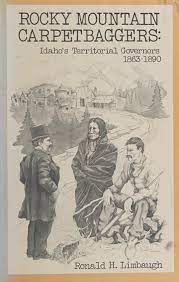Articles/Essays – Volume 17, No. 4
Political Hacks in the Idaho Territory | Ronald H. Limbaugh, Rocky Mountain Carpetbaggers: Idaho’s Territorial Governors, 1863–1890
Ronald H. Limbaugh’s Rocky Mountain Carpetbaggers chronicles Idaho’s gubernatorial administrations—maladministrations?— during its territorial years. The scenario Limbaugh creates runs as follows: (1) a petty politician has connections in Washington; (2) he is appointed to the territorial governorship; (3) he clashes with equally petty politicians in the territory; (4) he serves briefly; (5) he resigns; and (6) the cycle returns to step 1. The details vary only as individuals of some what more or less talent find their way to Boise. Limbaugh’s book rests on his dissertation. He has used secondary sources, newspaper accounts from the period, and appropriate collections of papers in the Northwest and the National Archives in his research. He deserves our praise for charting the dreary procession of political appointees; however, the book is not without some problems.
Limbaugh sometimes leaves the reader mired in detail without a clear sense of a main thesis. For example, he uses carpet bagger in the title of the book and notes the incessant harping of Idahoans against outside appointees. And, though I assume Limbaugh is not responsible, the picture on the dust jacket juxtaposes a diminuitive, pudgy governor with carpetbag in tow against an Indian (stoic) and pioneer (rugged). Yet Limbaugh himself observes that the carpetbagger charge was largely meaningless; the outside appointees were neither notably less talented nor appreciably less honest than the politicians who lived in Idaho territory. Limbaugh might also have added that any white person in Idaho who called another white person a carpetbagger in the 1860s or 1870s possessed a very short memory.
If the carpetbagger issue was empty, what issues did dominate Idaho territorial politics? I would have been more comfortable with the book if Limbaugh had explicitly identified these issues and organized the book around how the territorial governors affected them — if at all. Instead, Limbaugh used the gubernatorial term as his organizational unit, leaving some issues unclarified. Just as the use of the presidential administration as the unit of analysis for national politics has declined in recent years, going beyond the gubernatorial administration would seem profitable, too.
The central issues of territorial politics that implicitly emerge from the book are leftover Civil War loyalties, especially in the early territorial years, how to deal with the Mormon population in southeast Idaho, and whether North Idaho would become East Washington. These issues are standard for Idaho territorial history and examining the long line of politicians passing through the office of territorial governor adds little to our understanding of them.
In recent years, historians looking at national politics have identified several cultural issues that had real impact on politics in the late nineteenth century. These issues, such as Sunday closing laws, prohibition, and parochial schools, were important political questions along with such traditional issues as Free Silver and the tariff. Limbaugh writes in the tradition of classic political history, but other traditions might also serve the study of Idaho. A historian might broaden our understanding by examining other ethnic or cultural questions than just the Mormon question. A close examination of who voted for whom might also get us beyond the almost meaningless maneuvers of the Boise or Malad “rings” that dominate the writing of early Idaho political history.
Finally, Limbaugh adopts the standard view of anti-Mormonism in Idaho in the 1870s and 1880s. There is no question, of course, that the anti-Mormon movement had a heavy dose of political opportunism—Fred T. Dubois springs to mind—and a hefty shot of the same hostility that existed toward Jews and Catholics, a deep suspicion of any religion that deviated from the mainline Protestant denominations. However, one must also grant to at least some, perhaps many, of the anti-Mormons a sincere antagonism toward Mormonism’s deviation from traditional patterns of family organization and sexual practice. It would be astonishing if Protestant Ameri cans of the late nineteenth century, surely as confident of their own righteousness as a group could be, did not attempt to either limit or eliminate the influence of a major institution in the Great Basin endorsing plural marriage.
Limbaugh covers much ground and many individuals. Any historian seeking an account of the Idaho territorial governors will certainly want to read Rocky Mountain Carpetbaggers. For that, we all owe Limbaugh our thanks and admiration.
Rocky Mountain Carpetbaggers: Idaho’s Territorial Governors, 1863-1890, by Ronald H. Limbaugh (Moscow, Idaho: The University Press of Idaho, 1982), 234 pp., notes, index.


 Back to full Issue
Back to full Issue

